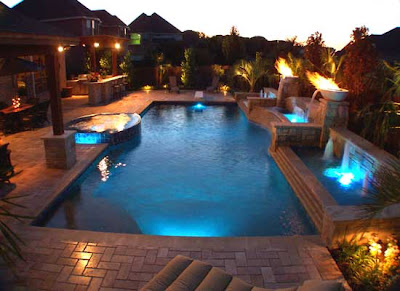The earliest recordings of swimming can be traced all the way back to 7000 years ago, where the Stone Age paintings clearly implied that swimming was practiced at that time. Moreover, historic books (from 2000 BC) that give written accounts of swimming are Gilgamesh, the Iliad, the Odyssey, the Bible (Ezekiel 47:5, Isaiah 25:11, Acts 27:42) and Beowulf. However, the style of swimming prevalent at that time is unknown. The popularity of swimming apparently grew in the Middle Ages. In 1538, a German professor of languages, Nicolas Wynman wrote the first swimming book 'Colymbetes'. The Encyclopedia of Traditional British Rural Sports states that swimming was also required of knights, and Romans built swimming pools at places they conquered. They regarded swimming pools places to exercise and as rostrums for social gatherings.
 |
| One of the modern type and high- class swimming pool. |
It was in the 1800s that organized swimming emerged. This time period viewed the formation of various swimming association which organized swimming competitions against each other. In fact, there have been records of swimming clubs set up in countries like US, England, France and Germany during that time. The English are believed to be the first modern society to consider swimming as a sport. The National Swimming Society in England organized swimming competitions that was conducted in London's six artificial pools. Mathew Webb's swim across the English Channel further increased the sport's popularity. Later in 1886, a new governing body, the Amateur Swimming Association of Great Britain was formed which fostered the popularity of swimming competitions.
As swimming gained popularity during the 1800s, organized swimming underwent another moult and brought forth the first modern Olympic Games in Athens in 1896. During this time, Olympics was a sport for men with the 100 meters and 1500 meters free style swimming, all held in open water. There were only four swimming events, of which three were free-style. As its popularity soared, more strokes like butterfly, breaststroke, backstroke, etc. were added to the event.
The developer of the modern Olympic Games, Baron Pierre de Coubertin, believed that women were too frail to participate in such competitive sports. It was only in the 1912 Olympic Games when the women swimmers made their debut. By the 20th century, swimming developed into a mainstream event with indoor pools and public outdoor pools being constructed all across the towns. Swimming clubs also surged in popularity with their image of being a recreational hangout. Today, Olympic Games includes 32 swimming races, 16 for men and women each and even holds 22 swimming events each for men and women with disabilities.Today swimming is the second most popular exercise activity in the United States, with approximately 360 million annual visits to recreational water venues.
No comments:
Post a Comment